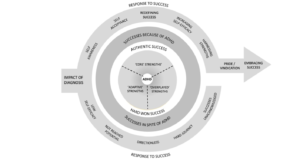This is a lay summary of Chapter 19 ‘Neurodiversity Assessment In Forensic Contexts, by Nancy Doyle, Lorraine Hough, Karen Thorne & Tanya Banfield’ – which appears in G.C., Fisher, M.J., & Jones, L.F. (Eds.) (2022). Challenging Bias in Forensic Psychological Assessment and Testing: Theoretical and Practical Approaches to Working with Diverse Populations (1st ed.). Routledge.

Who was this chapter written for?
This Chapter was written for Forensic Psychologists working with neurodivergent people in prisons. Drawing on a proposal by Judy Singer, the authors agree that that there is nothing inherently disabling about ADHD, Autism, Dyslexia, Dyspraxia, and that diversity in the way we think is a natural feature for humans.
Problems with umbrella terms
We noted that the UK Criminal Justice Joint Inspectorate Neurodiversity Review (CJJI, 2021) used Neurodiversity as an umbrella term referring to the group of conditions falling under the category of neurodevelopmental disorders (NDDs). We suggested it is better to use ‘neurominorities’ or ‘neurodivergence’ as umbrella titles, because neurodiversity itself includes everyone. There are more neurominorities in prison than there should be, considering how many there are in the population in general. This means that Forensic Psychologists should be aware that lots of people in their care may be neurodivergent, as the following summary shows:
| (CJJI, 2021) |
Over 50% of the prison UK population is dyslexic. |
| (McNamara, 2012) |
Up to 80% of people in a UK prison have some kind of speech, language or communication difficulty. |
| (Young et al., 2018) |
Approximately one quarter of people in prison in the UK would meet diagnostic criteria for ADHD. |
| (CJJI, 2021) |
Approximately 5-7% of those meeting Liaison and Diversion services in the UK have Autistic traits, with around 16-19% of those in prison showing signs of Autism. |
| (Prison Reform Trust, 2021) |
Approximately 34% of people in custody in the UK have a Mild Intellectual Disability (MID) or Borderline Intellectual Functioning (BIF). |
| (Prison Reform Trust, 2021) |
49% of women and 23% of men in custody in the UK have been diagnosed with anxiety or depression. |
| (Shiroma et al., 2010)
|
Estimated brain injuries amongst Criminal Justice System populations vary significantly based on the populations being studied and the assessment method, but analysis of international studies suggests that rates of brain injury in convicted populations is approximately 60%. |
Diagnosis
Many neurodivergent people in prisons do not know that they are neurodivergent, or don’t have a diagnosis. Does this mean that Forensic Psychologists should try to make diagnoses using specialist tests? We explained that neuropsychology is not finding strong evidence for neurominorities as separate diagnoses. In fact, there is more in common across the different conditions than there are features to separate them. Because of this, it is hard to make accurate diagnoses.
We also explained that diagnosis is made difficult because of intersecting identities, such as those in this table, which are affected by biased definitions and tests:
| Gender |
- Definitions, tests and questionnaires make it easier for boys to be diagnosed. This is because they ask for examples of behaviour that is more normal for boys.
- Also, girls get stronger messages about sitting still, being sociable, reading and writing. Boys get stronger messages about being physically active and good at maths.
- Transgender communities have fewer differences between male and female diagnosis rates.
|
| Race and Ethnicity |
- Definitions, tests and questionnaires make it easier for white people to be diagnosed. This is because they are based on things that are more usual for white people, such as the way we make eye contact and talk.
- It is also because teachers, psychologists and medics are already making too many snap judgements about people from non-white communities, such as Black people, Roma people, Asian people. They are often seeing white people as less ‘difficult’ and calmer, so they think if there is a difficulty, it must be medical, whereas for Black or Brown people they are assumed to be ‘bad’.
|
| Poverty |
- Wealthy families can afford private diagnosis and are more likely to be diagnosed if they need to.
- Wealthy families can afford private tutors and private schools so their children are less likely to need help at school.
- Wealthy families are more likely to have time to help their children with homework and being organised. They are also more likely to jump in to resolve social and emotional difficulties.
- A family’s wealth makes a difference to how people get diagnosed and when
|
When we added together the differences for different types of people, and how unreliable testing is, we advised psychologists working in prisons to focus on needs rather than labels. We advised working with different types of testing (see following table) to assess neurodivergent people in prisons.
| Tests |
Important facts |
Strengths |
Limitations |
| Cognitive ability testing (standardised)
|
MUST be validated with data analysis and approved by a peer review publication. |
Gives very accurate information about how well a person thinks using different areas of thinking – verbal skills, memory etc |
Expensive, takes time. Not always immediately helpful to a person who wants to know what to do next. |
| Self-Report questionnaires (standardised)
|
Must be validated with data analysis to check how reliable the answers are.
Good ones will also be approved by a peer review publication. |
Makes sense to people taking the tests.
Useful for thinking about what to do next. |
Can be affected by how the person feels on the day. They might answer differently at a different time or on a different day. |
| Testing that has not been standardised (whether self-report or ability testing) |
|
These provide information about a person’s experience. |
They cannot be used to make predictions about what people might need. |
We then explained what types of help are useful for different challenges, rather than recommending help based on a label.
| Challenge |
Recommendations for potential strategies and reasonable adjustments |
| Executive functions – working memory and processing speed |
- Memory aids /strategies – little and often; rehearsal; recency and primacy issues, so structure key messages; mnemonics; visual imagery; internal aids; external memory aids – post-its, alarms, to-do lists etc. Chunking.
- Concentration techniques such as anchoring, visualisation and hunger / time of day, self-awareness
|
| Executive functions – planning, time management and organisation |
- Environmental aids such as signposts; labels; orientation boards; colour doors; wayfinding lines showing routes; use of daily routines.
- Errorless learning: break down tasks into smaller steps; build in opportunities for success; graded activities to ensure success. Teaching functionally equivalent or functionally related skills.
|
| Language – verbal |
- Simplify complex instructions and avoid abstract tasks. Promote learning by doing. Repeat if needed.
- Practice role play conversations that come up frequently; develop exercises to assist offenders during questioning. This might include supporting them to self-advocate with comments such as “sorry I can’t process that all at once, can you ask me just one question at a time?”
- Develop packs of prompt cards for asking for help / more detailed instructions to support people in daily interactions within the prison and through the gate, such as above or:
“Can I stop you there? It would work for me if you allow me to practice while you talk, I remember better that way.”
“I’m sorry, I find it hard to process lots of words, could you possibly slow down?”
- PQRST – preview, question, read, study, test – this is a useful structure to support individuals with learning new information.
|
| Language – written |
- Advocate for education departments to have access to assistive technology to meet demands of the modern world through the gate.
- Avoid temptation to replace 12 years of education with a 2-week literacy course, often not adapted for neurominorities. For example, phonic tuition alone may not correct spelling and reading difficulties; new strategies should be applied if these have failed repeatedly.
- Literacy support charities might offer a more specialised programme and can help with providing differentiated material that inspires engagement.
|
| Motor control and balance |
- Train techniques for managing state and dealing with panic. Support individuals to avoid self-shame, slow down and take time with tasks that they find difficult.
- Advocate for education departments to have access to assistive technology – handwriting is reasonably obsolete in modern workplaces. Touch typing may be more appropriate to learn.
- Planning and practising movements and journeys before starting.
- Rehearsal of frequently required motor control tasks.
|
| Sensory Sensitivity
|
- Training awareness of sensory trigger and strategies for avoiding these within the Justice System. For example, planning days and wall chart reminders of which events happen in which order can help identify where sensory triggers are and how to avoid / reduce them.
- Advocate for adjustments like ear defenders wherever noise disruption is an issue; or wearing of sunglasses, reducing glare from strip lighting, as well as general notes on temperature, smell, touch and taste sensitivities.
- Touch is particularly of relevance during shutdowns, when any attempt to physically approach a neurodivergent person may exacerbate defensive aggression rather than calm or control an outburst.
- Psychologists can strongly advocate for decompression time and space for those who are sensory sensitive.
|
| Emotional dysregulation |
- Regular reflective, coaching-based sessions to increase self-awareness are essential for most neurominorities.
- Unhelpful or frightening behaviours can be supported by reinforcing positive behaviours; use of TOOTS, (Time Out On the Spot)
- Structure sessions / session plans; anticipate hot spots.
- People frequently exhibit warning signs, such as knee jiggling or nail biting, or breath holding, which indicate a pre-shutdown.
- Developing self-awareness of triggers can facilitate self-advocacy before a shutdown.
- Verbal communication is compromised during intense emotions. To counter, role-play short effective phrases to help attract support rather than control from staff. For example:
“Can I self -isolate please, I am going into autistic meltdown?”
“Help, fight or flight response happening.”
“Help, trauma flashback happening.”
- Adopt a coaching response, predictability / stability; create consistency across staff groups; use planners; set goals; use checklists, enable individuals to plan and structure their day.
|
We hope that this information helps people working in prisons to make a positive difference for neurodivergent people in prisons.
References
CJJI. (2021). Neurodiversity in the Criminal Justice System: A review of evidence (pp. 1–77). Criminal Justic Joint Inspection.
McNamara, N. (2012). Speech and language therapy within a forensic support service. Journal of Learning Disabilities and Offending Behaviour, 3(2), 111–117. https://doi.org/10.1108/20420921211280097
Prison Reform Trust. (2021). Bromley Briefings Prison Factfile (p. 66). Prison Reform Trust.
Shiroma, E. J., Ferguson, P. L., & Pickelsimer, E. E. (2010). Prevalence of traumatic brain injury in an offender population: A meta-analysis. Journal of Correctional Health Care : The Official Journal of the National Commission on Correctional Health Care, 16(2), 147–159. https://doi.org/10.1177/1078345809356538
Young, S., González, R. A., Fridman, M., Hodgkins, P., Kim, K., & Gudjonsson, G. H. (2018). The economic consequences of attention- deficit hyperactivity disorder in the Scottish prison system. BMC Psychiatry, 18, 1–11. https://doi.org/10.1186/s12888-018-1792-x




